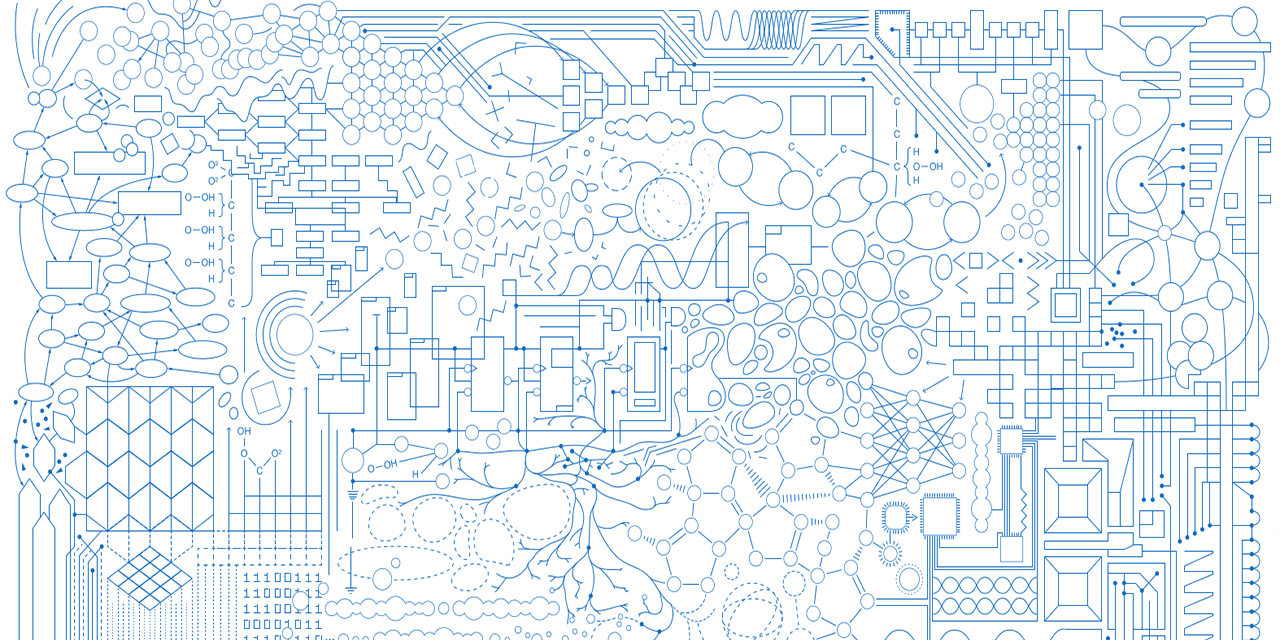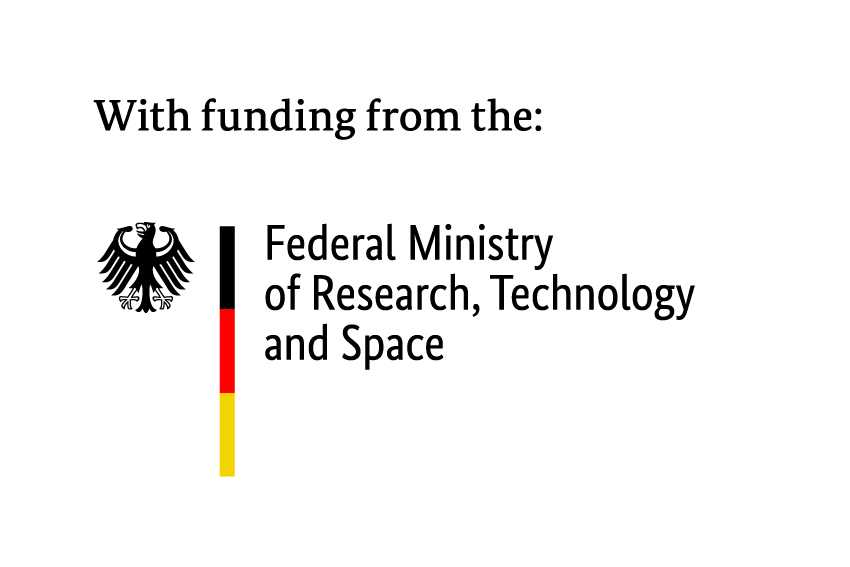Research in Times of War – “The War Added One More Factor – the War Itself”

For over a year now the war is raging in Ukraine. Anna Laktionova and Svitlana Shcherbak, two philosophers from Kiev, left after the invasion. They are fellows at c:o/re, an advanced studies center at RWTH Aachen University that focuses on different research cultures and how they change in times of global challenges and transformations. War can have an impact on research, too. It first of all threatens and takes lives and destroys homes – but it can also radically change the scholarly landscape. Concidering the terror against civilians, I was hesitating for a long time to ask Anna and Svitlana about research in times of war, but I finally approached them and asked if they would be open to talk about their experiences during the past year. They agreed, although they both told me how tough and challenging it was to speak about this. I am very greatful that they shared their personal stories and professional perspectives.

Svitlana Shcherbak
Svitlana Shcherback is a researcher with a professional focus on political philosophy, discourse analysis and the political development of Post-Soviet states. She has years of experience in various (international) research projects, for example with the National Academy of Sciences of Ukraine or with the Catholic University of America, Washington, DC. In her current studies as a c:o/re fellow, Svitlana works on the aspect of “modernization” in ideological discourses of Post-Soviet states namely in Russia and Ukraine
Stefanie Haupt: When did you become certain that the Russian government was serious about attacking Ukraine? May I ask how you experienced the weeks before, the day of the invasion and the weeks following it? What were your thoughts and when did you decide to leave?
Svitlana Shcherback: It is still not easy to remember the first days of the war. When the embassies of the USA and European countries announced the evacuation of their staff, it became clear that the threat of a Russian attack was quite real. I understood that it was a realistic scenario, but I did not want to believe it until the very end. The slightest hope remained that it was just a bad joke. It seemed to be unbelievable that Putin could make such a decision, which turned out to be a disaster not only for Ukraine, but also for Russia. It was such a terrible and stupid decision that I hoped until the very last minute that it would never happen.
However, a premonition of war was in the air, and in my daily life I acted as if the war was inevitable. I was getting ready for it, buying some important things like medicines and putting my current affairs in order. I used to shop abroad via the Internet; the Ukrainian postal services were quite reliable and fast. However, just before the war, I resisted the temptation to shop abroad, assuming that I would not get it because of the war.
On February 19th, I was together with my children at a concert in the Kiev Philharmonic Hall, we listened to Mozart’s Requiem. Later we often remembered that concert; it was so symbolic… On the 24th of February, we were woken up at about 5 a.m. by the sound of a rocket flying over our house. I remember the feeling – it has happened; there is no more hope, it is war! My kids were frightened, but I felt neither fear, nor despair – the waiting was difficult, but all that was needed now was action. Nobody knew what was going to happen. We lived in the outskirts of Kiev, not far from Gostomel and Bucha, and I never knew that waking up at dawn to the sounds of fighting was going to be our daily routine, that we would learn to identify the sounds of rockets and to determine the direction of fire. In short, that we would acquire the skills that my relatives in Donetsk had acquired long ago, and far better than us.
I had stayed in Kiev for two weeks with my son, while my husband evacuated our daughter and his parents to the countryside near Cherkassy. My mother’s house is in Gostomel, near to the airfield where the Russian airborne troops landed. I was so happy that she was in Germany at the time, because the fighting was right next to her house. It miraculously survived, although it was left without windows and partly without a roof.
From the first day of the war, all shops except the large supermarkets were closed, public transport was at a standstill, and getting to other parts of the city, especially across the Dnipro River, became a challenge. Kiev was being attacked by the Russians from different sides, and the city streets were partially blocked by anti-tank hedgehogs and cement blocks. Our daily routine had been reduced to the task of survival.
It was clear that the Russians overestimated their military forces and misjudged the situation in Ukraine. They expected an easy and quick victory, obviously believing their own propaganda cliché about the ‘Nazi government’ and ‘pro-Russian people’ in Ukraine. But it soon became obvious that the war would be long and bloody. I did not want to put the children in danger, especially my daughter – she has diabetes, and I realized that because of the war it would be difficult to provide her with all the medicines and equipment she needs to live.
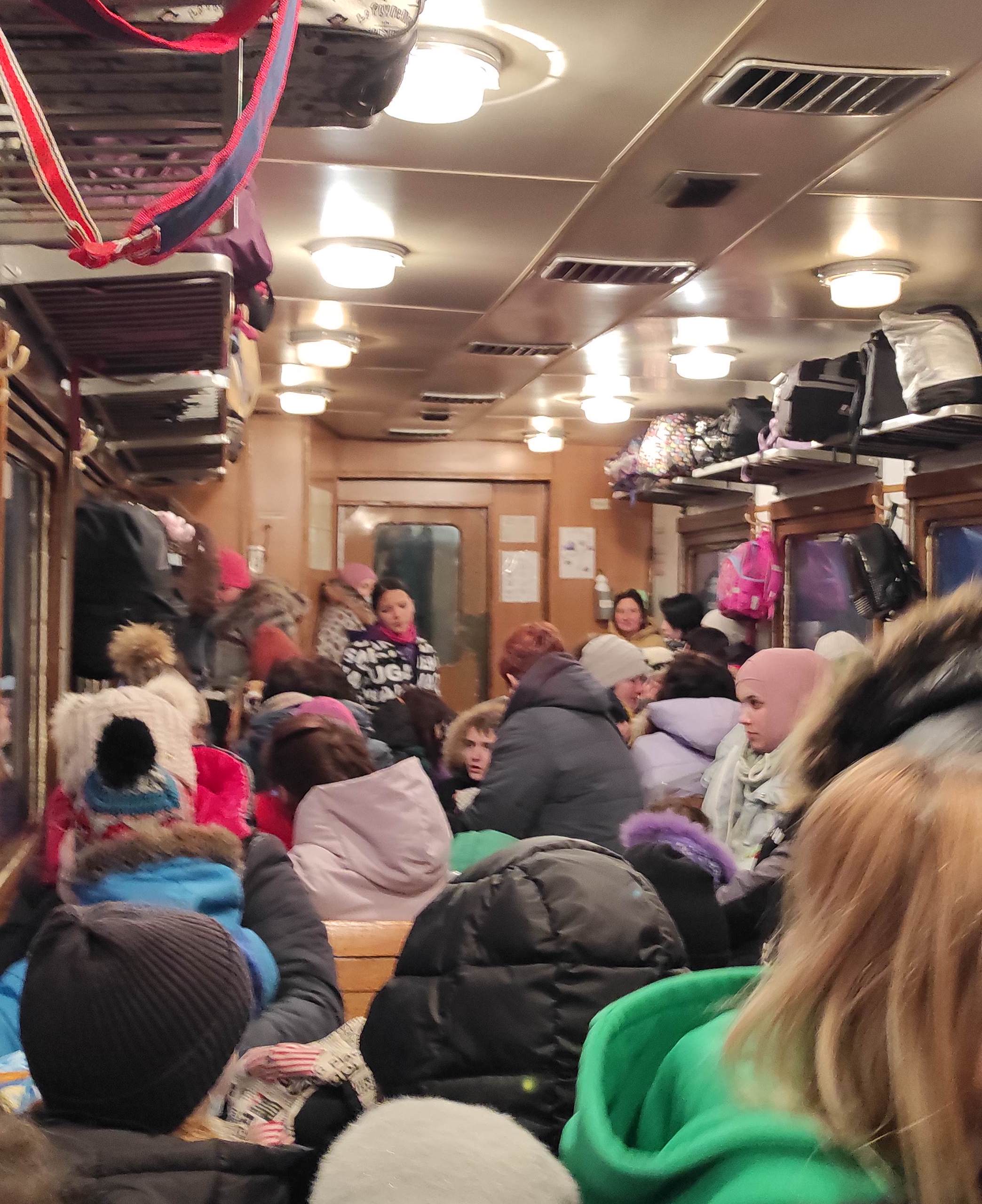
In the early days of the war, it was extremely difficult to leave Kiev. We could only get out of the city by car or on so-called evacuation trains, overrun by crowds of frightened people. The roads were also jammed, there were roadblocks and traffic jam for miles, and it was very hard to get petrol. It took me a while to decide what to do and where to go, and to get ready for the long journey with two kids. It was scary to go almost nowhere with children. I also waited for the flow of refugees to subside. In the end, we had to take an evacuation train from Cherkassy to Lviv, and, you know, after that trip, other troubles seemed less troublesome than before. I decided to go to Germany, because my mother lived in Ober-Olm, near Mainz.
Two weeks of our stay in Kiev had not passed without a trace. When we arrived in Germany, for the first time we tried to identify the type and direction of a flying rocket, when we heard the sound of an airplane. We forgot that airplanes could be peaceful. And we had only been in Kiev for two weeks. I can only imagine what people in Mariupol or Kharkiv must have gone through.
When the war started, I was in pieces for several reasons. First and foremost, war means death. So many people have already died, and I do not know how many more deaths the war will bring. I was born in the East of Ukraine, in Donetsk. I spent part of my childhood in the countryside, near Zaporizhia. Hot summer days, endless meadows and fields of wheat and sunflowers, cut through with woodland belts, and the high blue sky above are still before my eyes. It is an arid steppe zone; there is no lush greenery, no big forests, no large rivers, just endless steppe and sunshine. Small villages scattered along the road. It pains me deeply to think that this land, my home country, is now being torn apart by the war.
I am a Russian-speaking half-Russian and half-Ukrainian, and although I have never identified with Russia, Russian culture is a part of my background. I know that Russia is very heterogeneous, as Ukraine is and even more so. I took the Russian invasion as a shot in the temple to all Russian-speaking people all over the world, not just in Ukraine. Attacking Ukraine was the worst thing the Russian authorities could have ever done for Russians.
This war is a real tragedy for both Ukrainian and Russian people, and we will have to deal with dire consequences of the war for many years… So many deaths, so much blood and destruction. As a child I often watched films and read books about war, mostly the Soviet ones, but not only. These books and films were different; most of them were rather propagandistic, showing the war just in black and white. But there were also films and books that reflected on the experience of war. For example, Ivan’s Childhood by Andrei Tarkovsky, Trial on the Road by Alexei German, Go and See by Elem Klimov, The White Guard by Mikhail Bulgakov, All is Quite on the Western Front by Erich Maria Remarque. Even as a child, I understood how terrible the wars must have been. War cripples the human soul. As my son said after coming to Germany and returning to a normal life: war should not exist. I believed that it would never happen again, and in my nightmares, I could not have dreamed that it would affect us directly… It seems incredible that this war was initiated by the country that suffered so much during WWII and that used this traumatic experience and the memory of the war as a basis for consolidating society. It seems that most Russians have not yet understood that from now on the responsibility for starting the war lies with Russia and that their children will have to deal with it.
However, I do not support the idea of cancelling everything that has to do with Russia. On the contrary, I think that this tendency makes Russians feel an existential threat and support Putin in his justification of the war as a forced necessity, mobilises them.
Stefanie: It is now one year since the war in Ukraine began. How did you manage to settle in and find routines at RWTH and in the city of Aachen? How did your professional life as a philosopher change? Does the war impact your research agenda? And if so, how?
Svitlana: Of course, the evacuation was not easy. I remember the evacuation train to Lviv, a city in the West of Ukraine. It was packed with people like sardines, and the journey took 16 hours. Let me not remember that time any more. War is always hard; it is a situation of the ultimate existential challenge, the encounter with death, and the ruin of infrastructure and institutions that form the basis of everyday routine.
We stayed at my mother’s for a short time. I soon found the opportunity to apply for a fellowship at the RWTH, and a week later we arrived in Aachen. In Germany, we were greeted with sympathy and compassion from the very beginning. I am so grateful to the people who met us and helped us, in particular to Rosemarie and Engelbert Gabel from Ober-Olm. In Aachen we stayed with Christina Veenhues, who also supported us, helped us get settled in and became a good friend of mine. It is not easy to name all the people who helped us, but I would like to express my gratitude to Ana de la Varga, Gabriele Gramelsberger, Julia Arndt and Mathias Sannemann, my children’s class teacher at the Anne-Frank-Gymnasium.
I am convinced that any research agenda you are deeply involved in has to be relevant to something really important in your life. Of course, the war has affected my research agenda.

In recent years, I have focused on the political and economic processes in Ukraine and how they are intertwined and influence each other. I was rather critical of the policies of the Ukrainian authorities during Petro Poroshenko’s presidency. In my opinion, the government focused too much on identity politics and neglected economic and social reforms. I was also concerned about the fate of southern and eastern regions of Ukraine. The problem was that the Ukrainian national project postulated a strong link between the preferred language of everyday communication and ethno-political identity (pro-Russian/pro-Ukrainian). These regions were largely Russian-speaking and a mixture of both Ukrainian and Russian cultures, and did not fit into this concept of Ukrainian identity. They were a kind of bridge between Ukraine and Russia; not surprisingly, they ended up becoming a ‘conflict zone’ (I owe this bridge metaphor to my colleague Roland Wittje).
Being a partisan of civic nationhood as a political identity built around shared citizenship within the state, I wanted Ukraine to be more democratic and liberal than it was and was going to be. That is why I was interested not only in applied research on political processes in Russia and Ukraine, but also in common issues of political philosophy. I strongly believe that understanding the post-communist space requires attention to the normative aspects of the ‘political’ and the analysis of developed countries, which turned out to be a kind of supplier and pattern of normativity for post-communist countries. Moreover, I believe that studying only endogenous factors is not sufficient for understanding the problems and challenges faced by post-communist countries, because their institutional configurations were largely formed in response to external influences, even if indirect.
The war added one more factor – the war itself. It heated up my interest in questions of ideology, propaganda, information warfare, post-truth and other issues related to political epistemology. I was interested in them before, but after the outbreak of the war, my interest to them increased enormously. The war in Ukraine, despite localised, has critically changed the world, and it will never be the same again. I mean not only in terms of geopolitical configuration, but also economic and institutional change. The conflict is far from over, and the question of what the world will look like after it is still open.
Stefanie: What are the circumstances under which researchers in Ukraine work? What would you say how the war is impacting academia there and in the post-Soviet states general?
Svitlana: Working conditions for Ukrainian scientists are not the best at the moment. The damage to Ukraine’s energy infrastructure has had the most negative impact because people’s lives are closely linked to the times when electricity is on. They often have to work at night.
The electricity situation is better now, but questions of how to survive on a daily basis are acute. Few of our colleagues have gone to the front, except on their own initiative, because there is a reservation for the conscription of scientists into the army.
Of course, any war is an existential challenge; it requires a special kind of reflection. On the one hand, we need to take a critical look at the processes in the post-Soviet space that made the war possible and, at some point, even inevitable. This reflection may turn out to be difficult, because the processes in Ukraine itself have been and continue to be very complex and controversial. On the other hand, the moral dimension of the war needs to be considered.
The war occupies the prominent place in the reflections of Ukrainian philosophers and social scientists – round tables, articles, journal issues and monographs are devoted to it. At the same time, even before the war, the agenda of Ukrainian public intellectuals tended to be rather right-wing than left-wing focusing mainly on identity politics. Now, for obvious reasons, it has become more radical. Beyond identity politics, Ukrainian researchers focus on moral issues, trying not only to conceptualise the existential and moral meaning of war, but also to describe current social processes and conflicts in terms of good and evil. I would even say that the front is now not only on the battlefields, but also on the pages of academic journals. Many of our colleagues define their task in terms of the war – to strengthen the consolidation of both Ukrainian and Western societies in their opposition to Russia.
I remember a conversation with a colleague who told me of his idea to write a book about Russia as a “Nazi” state. I argued that one could talk about fascist tendencies in Russia, but not about Nazism. He agreed after a short discussion, but said that for him the writing of such a book was a kind of fight against Russia. Never mind that it would mean deliberately deluding the public (against one’s own better knowledge).
I am aware that involvement is inevitable; as a good song about the Second World War says, ‘I am not involved in the war; the war is involved in me’ (thanks to Ilya Vorobyev for the idea). However, I consider critical reflection to be an essential part of our professional task and our professional ethics, and I personally cannot refuse it.
The focus of most Ukrainian intellectuals on identity politics leads to a neglect of the problems with various reforms, especially the labour law reform that is currently being implemented in Ukraine under the guise of a ban on criticism of the government’s actions during the war. I would recommend reading a recent article by Volodymyr Ishchenko in the New Left Review on this issue.
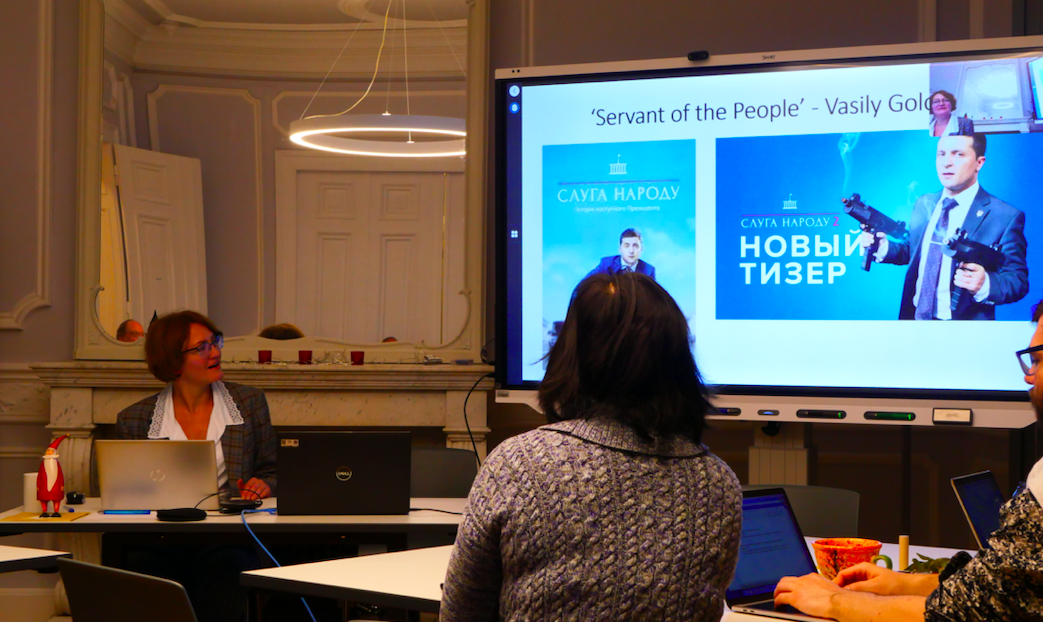
Stefanie: Do you observe differences and/or similarities between research cultures in Kiev and in Aachen? And in what direction does your own research develop now?
Svitlana: The question of the research cultures is rather complicated to answer in a nutshell. I see both differences and similarities between the research cultures in Kiev and in Aachen, resulting on the one hand from the Soviet past of Ukrainian philosophy, and on the other hand from its kind of postcolonial status today. One of the most striking differences between the research cultures in Kiev and in Aachen is the lack of theoretical discussions among Ukrainian philosophers. The question of the peculiarities of Soviet philosophy and its institutional functions has been discussed many times, mainly by Russian philosophers. Despite the fact that philosophy in the Soviet Union was saturated with ideology, there was some free space for thought. Of course, the works of Karl Marx and Vladimir Lenin created a corpus of ‘sacred texts’ that described reality in the only possible and truthful way, but they were not comprehensive. In particular, the development of science and the emergence of new disciplines had raised many questions. Philosophy existed in this gap between the prescribed ideological ‘credo’ and the living reality. Discussions sometimes did not follow the logic of their own discursive field, but the logic of the apparatus struggle. However, the common language and methodological framework enabled discussions between philosophers and scientists in the Soviet Union.
After the collapse of the USSR, the philosophical space became fragmented. First, national languages of philosophizing began to develop. Russian lost its function as the main language of communication, and Moscow ceased to be the centre of attraction for intellectuals from the post-Soviet space. Second, Ukrainian researchers were mostly re-oriented towards different philosophical schools and centres in Europe and the USA. They began to play the role of representatives of various Western philosophical schools in Ukraine. Some Ukrainian philosophers see their main task as representing the current trends and disciplines of Western philosophy at the university and in translating of relevant texts. Some do hermeneutics or phenomenology, others communicative or analytical philosophy, and so on. This means that philosophy in Ukraine is more receptive than productive.
Of course, Ukrainian philosophers’ work is not just a historical and philosophical representation of the Western philosophy. There is a number of original and interesting works in Ukrainian philosophy. But they are thematically and methodologically linked to and included in Western philosophical discourses. These books and articles are often published in other languages and become part of the work of researchers from Ukraine, but not of Ukrainian philosophy.
My sketch is rather superficial, I must admit. There are some books devoted to philosophy in the post-Soviet countries, particularly in Ukraine. I would recommend, for example, Mykhailo Minakov (ed.), Philosophy Unchained: Developments in Post-Soviet Philosophical Thought (2023).
Stefanie: I think, your analysis is far from superficial. Thank you Svitlana, for sharing not only your professional perspectives on the academic developments in Ukraine but also on your very personal experiences in the past year.
Svitlana: Thanks, Stefanie, for your in-depth questions. I very much appreciate the opportunity to speak out as one of Ukrainian voices.
Research in Times of War – “Scientific Life Somehow Goes on…”

For over a year now the war is raging in Ukraine. Anna Laktionova and Svitlana Shcherbak, two philosophers from Kiev, left after the invasion. They are fellows at c:o/re, an advanced studies center at RWTH Aachen University that focuses on different research cultures and how they change in times of global challenges and transformations. War can have an impact on research, too. It first of all threatens and takes lives and destroys homes – but it can also radically change the scholarly landscape. Concidering the terror against civilians, I was hesitating for a long time to ask Anna and Svitlana about research in times of war, but I finally approached them and asked if they would be open to talk about their experiences during the past year. They agreed, although they both told me how tough and challenging it was to speak about this. I am very greatful that they shared their personal stories and professional perspectives.

Anna Laktionova
Anna Laktionova is Professor of the Department of Theoretical and Practical Philosophy at Taras Shevchenko National University of Kyiv, Ukraine. Among other topics, such as theory of knowledge, and the legacy of Ludwig Wittgenstein, she explores the reciprocally additive character of the relation between “is” and “ought”. In her research project as a c:o/re fellow, Anna explores the possibilities of engaging Philosophy of Technology and Philosophy of Science with Philosophy of Action and Agency.
Stefanie Haupt: I remember waking up in the morning of the 24th of February 2022 to the news of Russia invading Ukraine. Although in retrospect everything pointed towards it – the occupation of Crimea in 2014, the weeks and days leading up to the war, the escalating rhetoric and actions – I was still shocked and could not believe it was actually happening. Looking back, I think that was naïve maybe. When did you become certain that the Russian government was serious about attacking Ukraine? How did you experience the weeks before, the day of the invasion and the weeks following it? What were your thoughts and when did you decide to leave?
Anna Laktionova: Even at 4.00 a.m. on the 24th of February 2022, early morning, when I was not able to fall asleep and I had been watching different news and information on the internet, I could not believe it to be possible. But then after two hours I woke up by the call from my brother telling me that there was already bombing of the North of Kyiv.
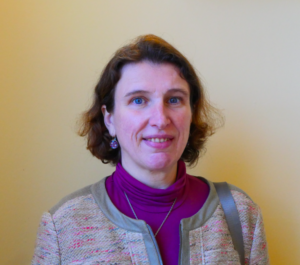
Since February, 7th, 2022, Vera, my 1-year-old daughter, my husband, and his mother (my mother-in-law, 82 years old) had already been in a rented flat in Uzhgorod (a nice town in the Western part of Ukraine, about 900 km from Kyiv). We had planned to spend half of the year there (the nature, climate etc. is very nice). But we also had a weird intuition about the Russian attack. We thought it would be much easier if I joined my family later than running away from Kyiv all together. As Covid was still spreading at that time, my teaching in the University was online, so I intended to join the family as soon as I felt ok – I did not feel well after I stopped breastfeeding Vera. So, no one in my family believed in a real possibility of war; but we had some intuitions, discussed them and decided not to risk our only child’s safety.
On the 24th of February 2022 at 8.00 a.m., I was already driving a car to Western Ukraine. I don’t have a car; from 6.00 till 7.45 I had been calling everyone of my close and not-so-close friends asking about the possibility to join someone who was heading West, explaining that I was alone, no luggage, just a knapsack (I took just documents, available money; not thinking about anything – even forgot my glasses as I was wearing contact lenses); and that I can drive (I have a driver’s license but no experience in driving as I don’t own a car anymore). Some friends of friends of friends had a car and old parents whom they wanted to send to the West, so I drove them to the small town Stryi close to the Carpathians. The road was extremely busy, the speed was mostly about 20 to 50 km per hour; it took us a bit more than 24 hours to get there. From there I got to Uzhgorod by local trains… On the way from Kyiv to the West, I saw Russian helicopters, aircrafts…
After a few days the possibility of a fellowship in KHK c:o/re Aachen opened up and I accepted it. I am very thankful to many foreign colleagues for trying to find ways of helping me! Me, my daughter, my mother-in-law, we crossed the border between Ukraine and Slovakia by foot on the 4th of March (no cars were allowed to pass through). My former classmates (who emigrated to Germany about 10 years ago) picked us up on the Slovakian side and we drove to Germany. On the border the situation was ‘very touching’: many men were accompanying women with children, helping with the luggage to the point of crossing the border, kissing, crying, and remaining on the Ukrainian side…
Stefanie: I can hardly imagine how much stress and uncertainty you must have experienced during this time. Did you manage to settle in and find routines at RWTH and in the city of Aachen? How did your professional life as a philosopher change? How does the war impact your research?
Anna: In Aachen, colleagues and staff from KHK c:o/re and RWTH were very kind and supportive (to name just a few: Gabriele Gramelsberger, Ana de la Varga, Julia Arndt). They and their friends helped us with everything: documents, finding a place to stay and live (the family of the owners of a flat where we live, the neighbours are also incredibly kind and caring), explaining about peculiarities of German institutions (the situation has also been challenging for them) and habits, also with finding a kindergarden for Vera (but she still doesn’t stay for more than one hour there without me) etc. etc. etc. I remember that in March and April on the streets I was meeting more and more Ukrainian women and children every day… Our situation in Aachen has been lucky enough. We are very thankful to many German people for the help, support, care!
My personal life has been and still is very much engaged with my daughter. It influences my professional life, my daughter is the first priority to me. Everything has been and still is not easy. I cannot participate in the professional life as much as I would like to and as I used to. The fellowship opened up new interesting very promising paths for my investigations, but I cannot accomplish them as largely as I want due to my personal situation.
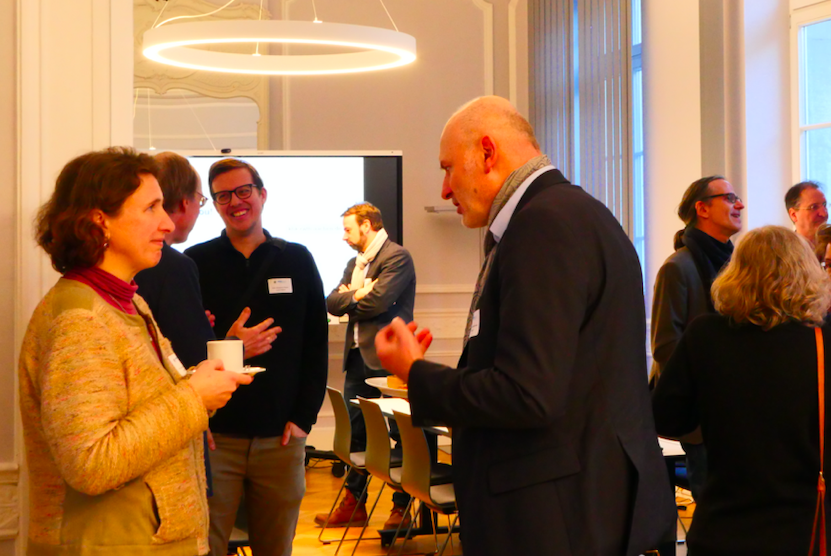
Stefanie: Do you have colleagues in your private and professional network that work at research institutions and universities in Ukraine? Do you know how the situation is for them? I know that you are also still teaching online. How is the situation for your students?
Anna: Colleagues in Ukraine are holding on. Everything is online, sometimes not online but by email correspondence because of problems with electricity, internet, unsafety, air raid alerts… Many of them are helping to support the Ukrainian Army…
Officially, being a fellow, I don’t have to teach, but I am continuing to supervise some post-graduate students and future magisters. I was also asked by the administration of the faculty from Kyiv to continue teaching some of my courses online, which I do. Some students are outside Ukraine, some stay at home, often not in Kyiv. Meeting online is not always successful: air alarms happen at different times and in different districts of Kyiv and parts of Ukraine. Often the communication is by e-mail correspondence and individual zoom-meetings. Some students are at war, some volunteer in the helping infrastructure. Last year, I was member in several PhD and Doctor of Science committees. Scientific life somehow goes on…
Stefanie: Thank you so much, Anna, for sharing very difficult and personal experiences!
Navigating Interdisciplinarity
If you would like to know more about the Navigating Interdiscplinarity workshop, which was organized by c:o/re, together with CAPAS and the Marsilius Kolleg Heidelberg, which hosted it, the CAPAS newsletter features an insightful article, here. You can also see our previous reflexion on the workshop, on the c:o/re website, here.
Historicizing STS @ c:o/re: Turning points in reflections on science and technology
GABRIELE GRAMELSBERGER, ARIANNA BORRELLI, CLARISA AI LING LEE, KYVELI MAVROKORDOPOULOU, BENJAMIN PETERS, JAN C. SCHMIDT, ROLAND WITTJE
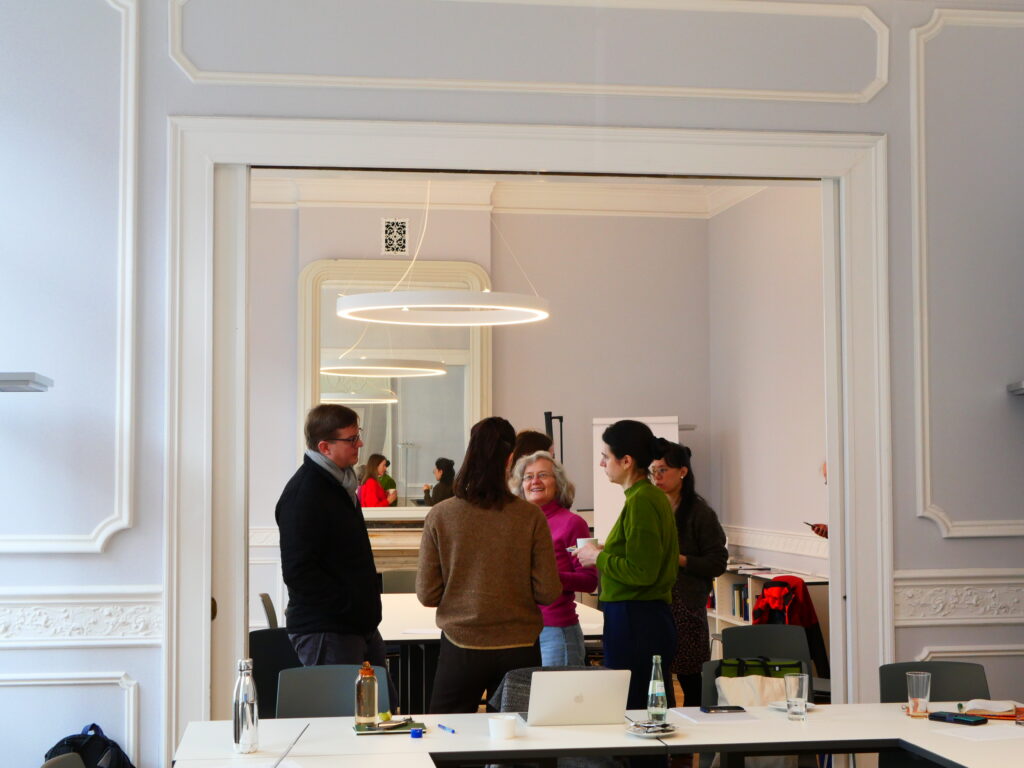
Photographer: Jule Janßen
On March 14th and 15th the workshop Turning points in reflections on science and technology: Toward historicizing STS took place at c:o/re. The aim of this event was to investigate the turning points in the intellectual history of Science and Technology Studies (STS) over the course of the 20th and 21st Centuries. Discussions converged to open up STS by historicizing this area of inquiry through explorations of the various turns in its development. As such, the meeting generated debates on the broad spectrum of notions of historicizing STS, as well of STS per se. It illustrated the interdisciplinary and multi-perspective study of STS that is being undertaken at c:o/re.
The event was organized in a carefully coordinated collaboration between c:o/re director Gabriele Gramelsberger and c:o/re research fellows. It served as a focused, c:o/re warm-up for the well-known STS Hub, which followed it, also hosted at RWTH Aachen University and organized by c:o/re director Stefan Böschen and other colleagues. The discussions benefitted from the attendance of Professor Ulrike Felt, who also delivered a keynote talk at the STS hub and is short term senior fellow at c:o/re during March 2023.
After Gabriele Gramelsberger, the main organizer of the Historicizing STS workshop, welcomed the participants to our Research Centre and explained the rationale of this meeting, c:o/re fellows Arianna Borrelli and Roland Wittje started off the academic debate. They chaired the panel Turning from History of Ideas and Artifacts to Practices and Society, with a focus on the increasingly close interplay between history of Science and Technology and STS, on the one hand and STS on the other, of which Lisa Onaga (Max Planck Institute for History of Science, Berlin) and Carsten Reinhardt (Bielefeld University) provided impressive examples.
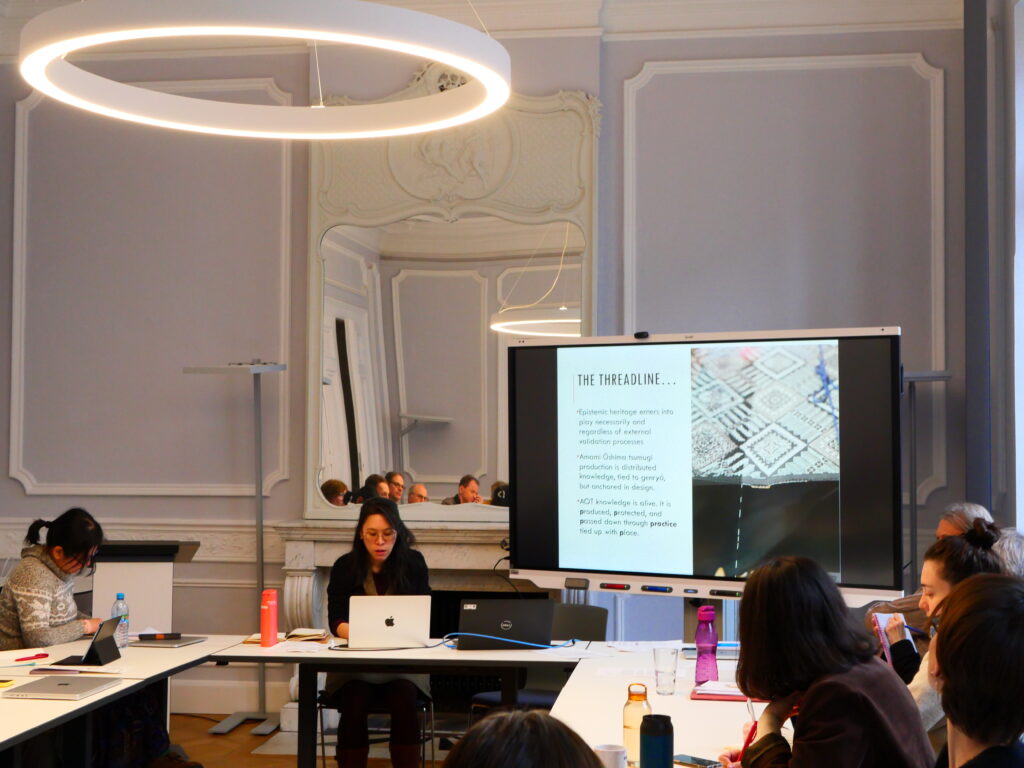
Photographer: Jule Janßen.
Lisa Onaga explored the practical turn in STS by focusing on silk craft. To recontextualize 20th Century Japanese modernisation and offer an example of how a community may reclaim its heritage, Onaga observed what she terms archipelagic thinking, that is, “seeing like an island”. Through this epistemic prism she explained how a remote community is aware of its being perceived peripheral while acknowledging itself as central to itself.
In his presentation, Residual Uncertainty in the Long Twentieth Century, Carsten Reinhardt addressed the Anthropocene through residue, as an analytical notion. This inquiry leads Reinhardt to a consideration of un/certainty, as a tension between striving for certainty and maintaining uncertainty. The debate pointed to the importance of reflecting on modernity through non-modern means.
As the second panel, c:ore fellows Benjamin Peters and Kyveli Mavrokordopoulou chaired Turning from Humans to Non-Humans, in a critical examination on anthropocentrism and its limits in the study of science and technology. Their invited speakers featured rising young scholars Salome Rodeck (Max Planck Institute for History of Science, Berlin) and Vanessa Bateman (Maastricht University).

Photographer: Jule Janßen.
Salome Rodeck presented on Hawaiian experiments, new imperatives, referring to Donna Haraway and reflecting on symbiosis science. Drawing also on the pioneering work of Lynn Margulis and the political turbulence of the 1960s and 1970s, Rodeck advanced a historically informed argument that dislocates anthropocentrism in Haraway’s work, particularly around microbial organism cooperation.
Vanessa Bateman’s talk was titled Animal Histories: Moving Between/Across STS, Environmental History, and Visual Culture. She addressed the project Moving animals on the globalization of non-human animals. Particularly, Bateman reflected on how long-distance movements of non-domesticated animals were studied, represented, and managed in US national parks. Close consideration of how elk populations adapt to human infrastructures and semiotic-material objects, such as a human-made fence that is an obstruction in a species’ environment, suggests new territories for nonhuman STS.
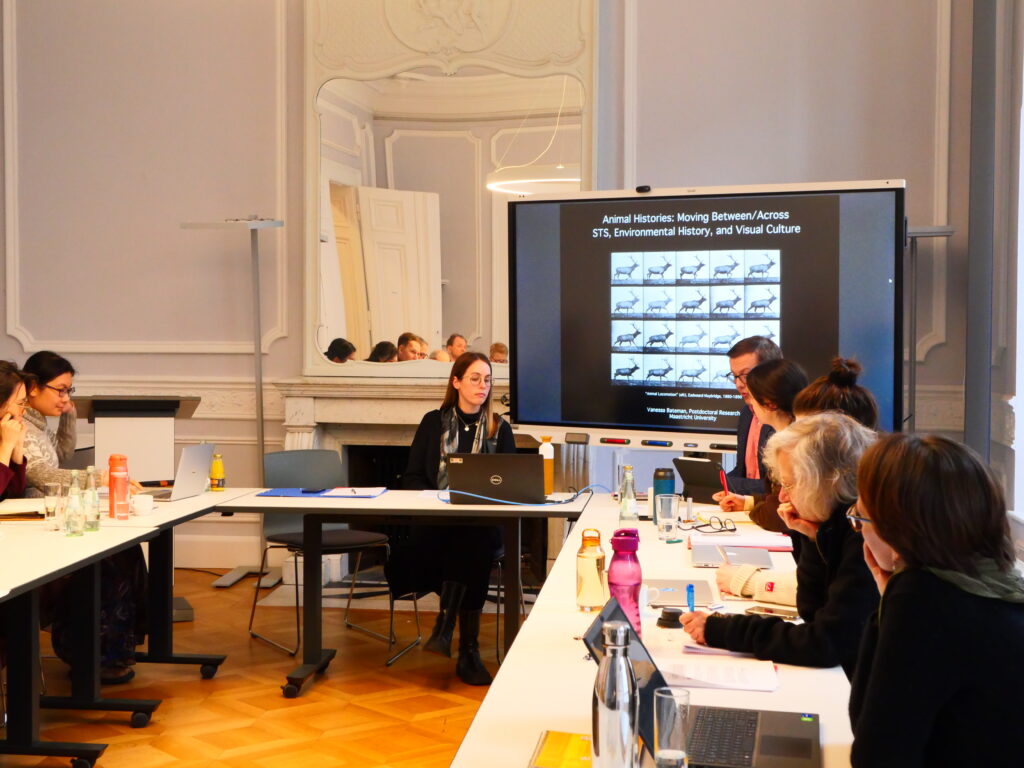
Photographer: Jule Janßen.
The third panel, “Turning points as epistemic shifts/epochal breaks”, was chaired by the c:o/re fellows Clarissa Ai Ling Lee and Jan C. Schmidt. In this panel, Andreas Kaminski (Darmstadt Technical University) asked whether ‘Hinge propositions’ are a way to identify epochal breaks? Following major epistemology scholars, from Thomas Kuhn to Friedemann Mattern, Kaminski pondered on how the world of observers changes once with the emergence of new ideas (or paradigms), through the deployment of Wittgenstein’s hinge propositions. Hinge propositions allow one to draw on the emergence of new expected, imagined and actual worlds. Hinge propositions could be used in the world-building of any world (including fictional worlds) so that the reader/audience/user/inhabitants of such world could take for granted that the rules governing such worlds are a priori determined and ‘historical,’ so that they could be ready to be deployed to emergent/new worlds. Therefore, hinge proposition is a fruitful instrument for conceptualizing turning points, shifts and epochal breaks.
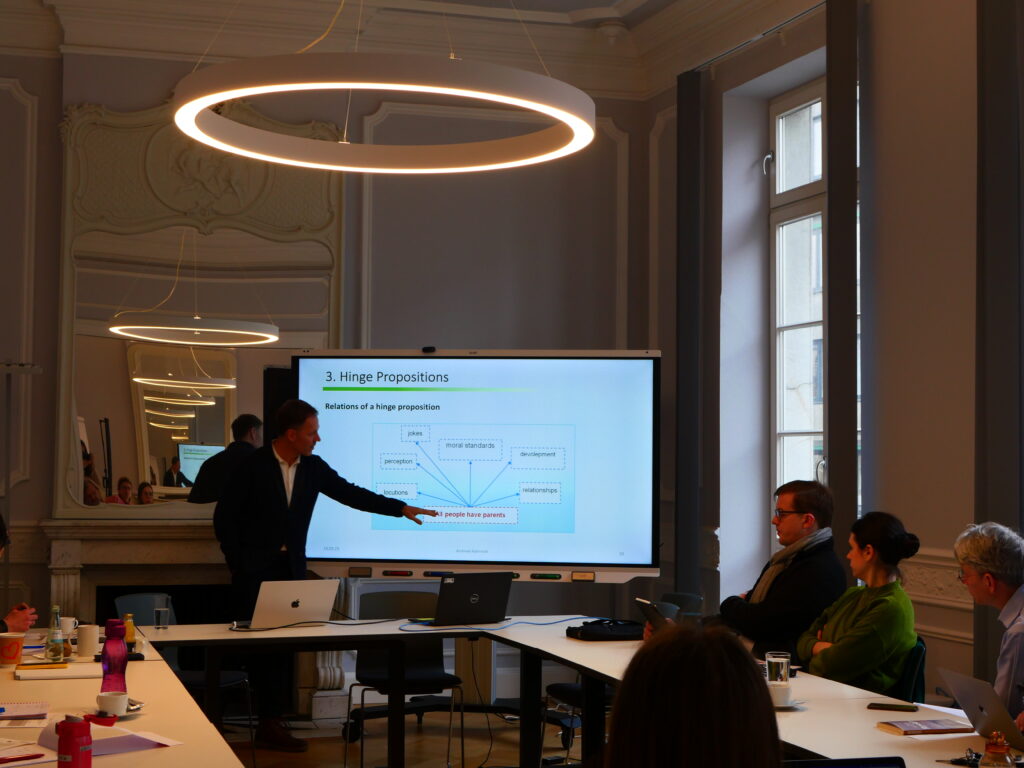
Clarissa Lee and Jan C. Schmidt wrapped up the discussions through a focused reflection on this third panel as well as on the workshop generally. In the closing, they call on the participants to reflect on what STS means by reminding them of the ‘messy’ genealogy that had made up the history of STS as a field and domain. Clarissa asked everyone to reflect on how topics, concepts and methods are co-opted into STS knowledge practices, and to consider the deliberations that had allowed new fields to be co-opted into a ballooning STS.
The c:o/re team is grateful to the participants and, of course, to the c:o/re fellows who made possible this interesting and insightful event.
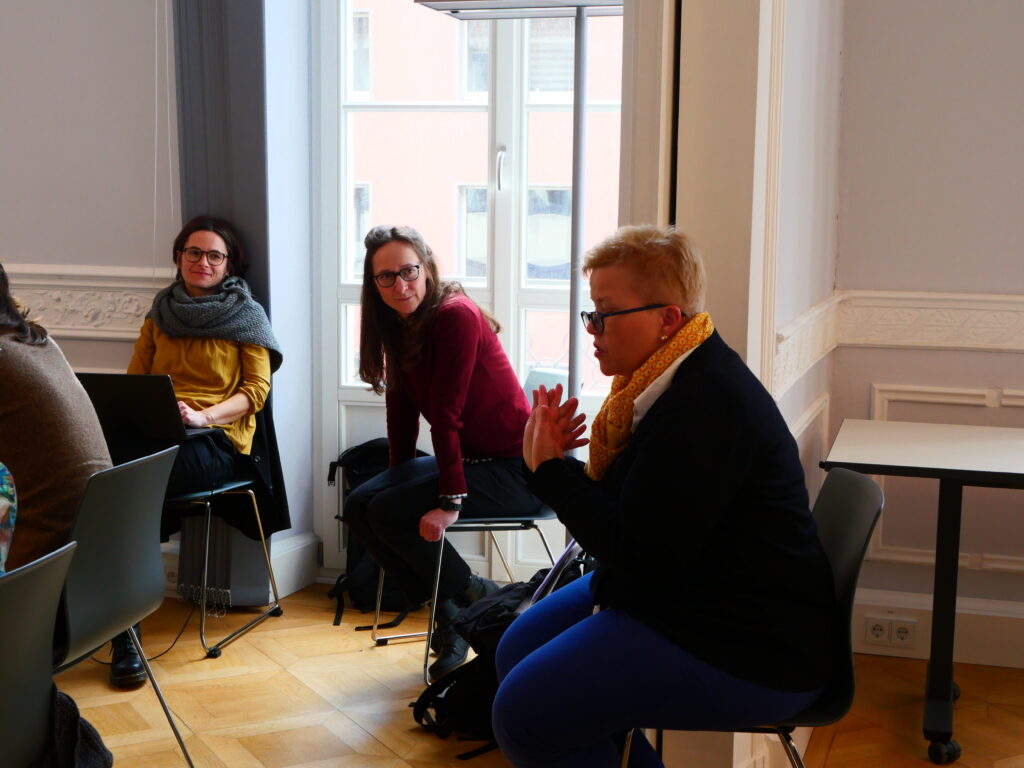
Photographer: Jule Janßen
Directors Gabriele Gramelsberger and Stefan Böschen explain the first two years of c:o/re in new interview with BMBF
Since May 2021, c:o/re has been dedicated to investigating research cultures: their similarities, differences and transformations. It examines how research is changing due to the scientific re-orientation towards complex systems and as a result of societal challenges. Gabriele Gramelsberger and Stefan Böschen discuss the Centre’s work this with the BMBF in this recent interview.
Models of complex systems as scientific-public boundary objects: The case of climate change. Complexity and Transdisciplinarity Graduate School of the Center for Advanced Studies (Aix-Marseille University), February 27-28
On February 27-28, 2023, the Complexity and Transdisciplinarity Graduate School of the Center for Advanced Studies (IMéRA), Aix-Marseille University is hosting an event on “Models of complex systems as scientific-public boundary objects. The case of climate change“, organized by Gabriele Gramelsberger and Alexandre Hocquet (Lorraine University, c:o/re alumni). To register, kindly contact Solenne Bruhl (solenne.BRUHL@univ-amu.fr). The event will feature the following talks:
27.2.2023, 14-16h Complex systems, climate modeling and managing of uncertainties – Managing the complexity of knowledge production
Gabriele Gramelsberger
28.2.2023, 10-12h Community models, standards and platforms: Managing the complexity of global collaboration and policy
Gabriele Gramelsberger
28.2.2023, 14-16h Research software: Managing the complexity of collaborative programming
Gabriele Gramelsberger & Alexandre Hocquet
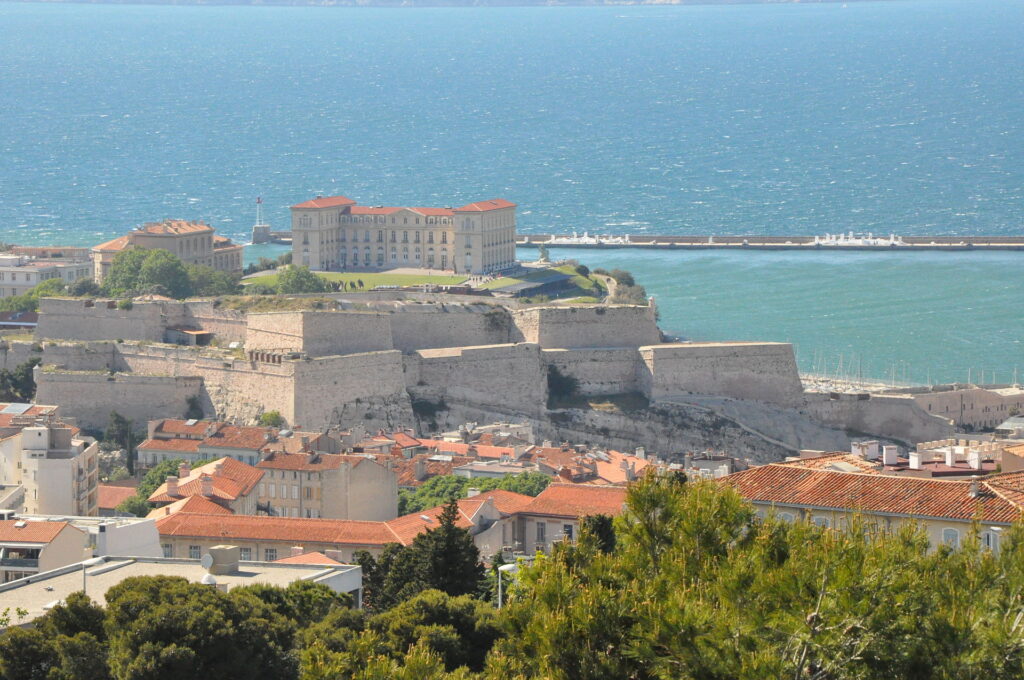
Talk by Stefan Böschen at the Austrian Academy of Sciences: Engineering turn? The shift in research cultures as a challenge for science research
On Tuesday, March 28, Stefan Böschen is presenting the work of c:o/re at the Institute for Technology Assessment at the Austrian Academy of Sciences. You can find the abstract and practical information on how to register on the website of the Institute for Technology Assessment, here.
Torsten H. Voigt on voodoo science, dead salmons and the Human Brain

On February 7, Professor Torsten H. Voigt, the Dean of the Faculty of Arts and Humanities at RWTH Aachen University, delivered a talk in the c:o/re lecture series on what has been referred to as “Voodoo science” . Professor Voigt argued that, as in science and philosophy in general, controversy functions as a driver for advancement and innovation in neuroscience. However, he explained, neuroscience as a discipline and community exhibits instrumental rationality in managing and avoiding meaningful controversy. This led to what may be termed an eclipse of reason, damaging or even destroying progress in the scientific field.
Neuroscience is enjoying great popularity, both within academia and in pop culture. and popular science. During the 1980s neuroscience cognitive became the new science of mind, by having incorporated molecular biology. This resulted in a study on a molecular level of how we think, feel and learn. Seen in this way, advertising of consumer goods, for example, reflects a connection established in pop culture between human capacities for creativity and the brain organ. These construals are not only employed in somewhat amusing ways in advertising, but they point to an unjustified optimism in academia. One reason for which this may be allowed, but which also raises suspicions about neuroscientific methods, might have to do with the very low reproducibility herein.
An important example that illustrates this type of process leading to an eclipse of reason, as Voigt argues, is observed in how the otherwise noted study by Vul et al. (2009) was largely ignored in neuroscientific research. The reluctance regarding this study was arguably met with from the start is suggested by the respective journal’s editorial board recommnending removing the expression “voodoo correlatons” from the title of the paper, as initially proposed by the authors.
Vul et al. (2009) observe mysteriously high correlations are claimed in neuroscientific research. This is explained by the fact that many experiments looked at a specific brain region instead of the whole brain as such in relation to behaviour. Despite drawing attention, the study has been ignored (low number of citations) by the community of neuroscientific researchers.
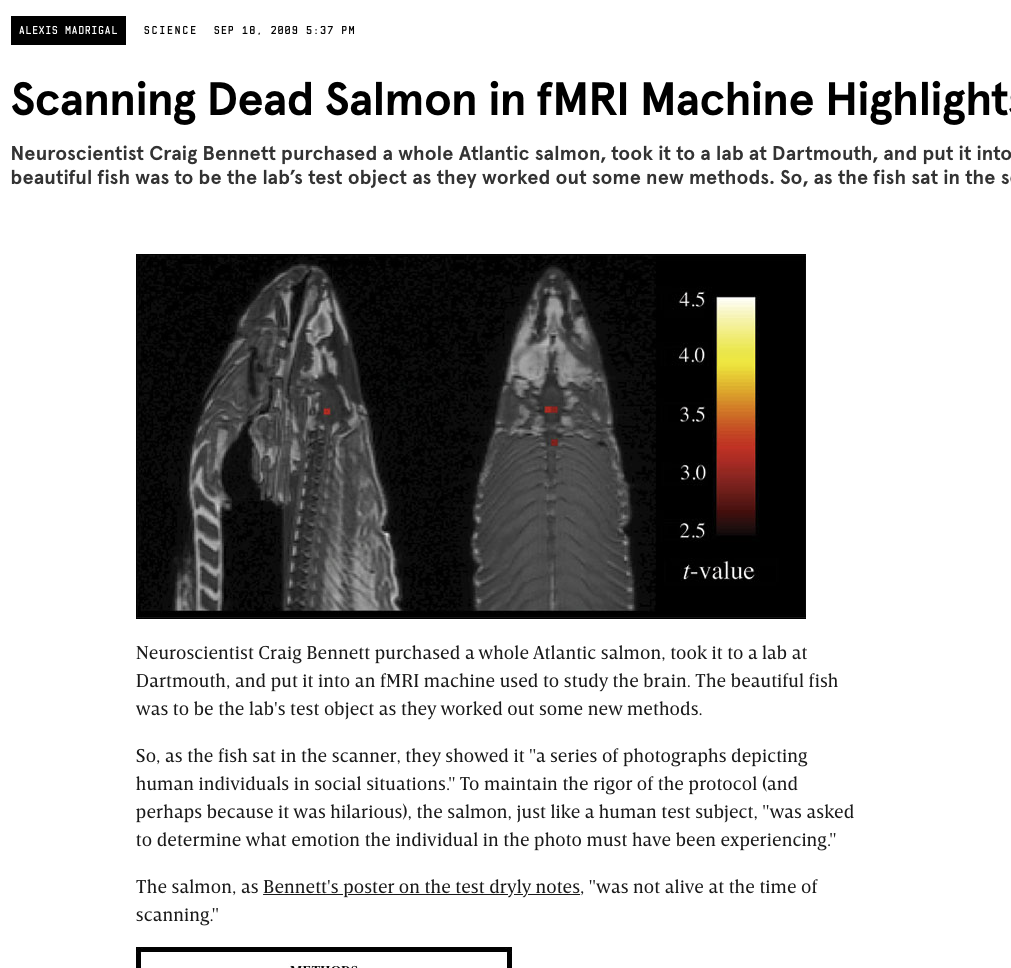
A prototype for signaling controversial matters in neuroscience, setting the tone of doing so in a controversial manner, is the famous “dead salmon” paper by Bennett et al. (2009), who ironically criticised neuroscientific methods by claiming correlations by observing supposed neural activity through fMRI in a dead salmon. The salmon, which “was not alive at the time of scanning”, “was shown a series of photographs depicting individuals in social situations with a specified emotional valence.” As neural activity could arguably be noticed in the image resulting from the scanning, the authors ironically claimed neural correlates of interspecies perspective taking”.
Another example that displays the eclipse of reason tendencies in neuroscience regards the Human Brain project, massively funded by the European Union. Arguably, the Human Brain project is not so much about the brain, as much as it turned out to be an IT infrastructure development project (Nature 2015). With such an example in mind, Voigt construes neuroscience, broadly, as an integration project
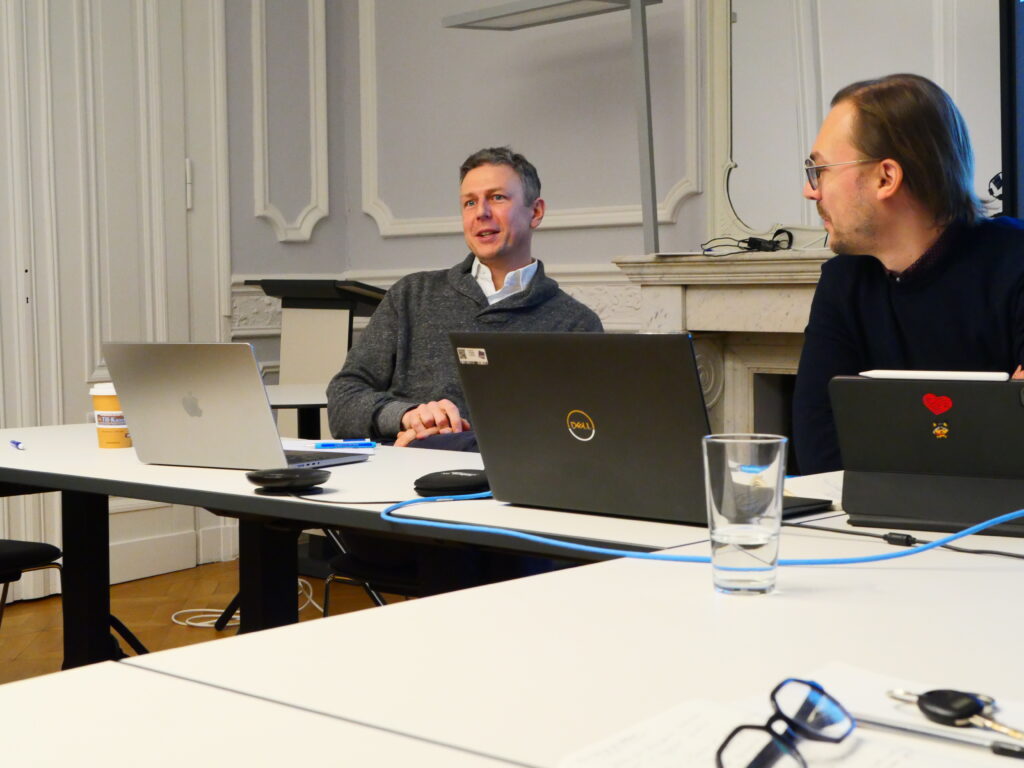
References
Vul, E., Harris, C., Winkielman, P., Pashler, H. 2009. Puzzlingly High Correlations in fMRI Studies of Emotion, Personality, and Social Cognition. Perspect. Pychol. Sci. 4(3):274-90.
Rethinking the brain. 2015. Nature 519, 389. https://doi.org/10.1038/519389a
Bennett, C.M., Miller, M.B., Wolford, G.L. 2009. Neural correlates of interspecies perspective taking in the post-mortem Atlantic Salmon: an argument for multiple comparisons correction. NeuroImage, 47, S125.
Politics of the Machines: Lifelikeness & beyond
Call for Track-Topics and Formats
Deadline Call for Track-Topics and Formats: 01 April 2023 New Deadline: 16th April 2023
The Call for Papers will follow after the Call for Track-Topics has closed.
_______________
The 4th POM Conference
Lifelikeness & beyond
RWTH Aachen University
KäteHamburger Kolleg:
Cultures of Research (c:o/re).
April 22-26, 2024
Life is in crisis. In society, this crisis has generated an uncertainty entangled with environmental injustices, health emergencies and the many faces of right-wing movements around the world – to mention some examples. Uncertainty might blurry the future and our capacity to make decisions, but it also opens up a space of possibilities. In this fragmented framework a new field for contingencies emerges. If we are unsure about what might be, alternative but unstable scenarios become possible. How does society react to those alternative scenarios? How are scientific and artistic communities responding to the various contingencies of the present?
In the wake of this era, we have been witnessing, in biomolecular research, the developments of programmable biosensors, synthetic biology and diverse biological entities that are aimed to be made programmable. These advancements amount to the crisis of life. These new phenomena in life-research have, for example, transformed the way in which we think about organisms and how life has evolved and transformed on earth.
At the same time, the fields of life-like robotics and computational evolution, which produce artificial entities modeled after living organisms – like self-reproductive algorithms and artificial neural networks – have brought to light questions regarding the qualities defining what is life at all. Life is being redefined by the parameters of its artificial models, so we are forced to rethink the question: what is the logic of living? The borders between machines and biological systems are being negotiated across the sciences and the arts at large, and novel questions and modes of thinking are emerging from these ontological reorganizations. Faced with these situations, one cannot help pondering on the limits of the possible and the limits of life.
Nowadays, machines can perform as agents that respond to contingent scenarios, they act as if they were alive. If life enters the space of formal logic and probability, if it is modeled, engineered and designed, does it follow the laws of logical inference? It is not only the difference between the organic and the inorganic that gets blurry, but also the one between the natural and the animated as well as the boundaries between necessity and contingency. What kind of models of contingency can be brought about that are helpful to respond to the crisis of life? What must technologies and artistic practices that cooperate with the living look like? How does this change life itself?
In our times, social ecologies are steered following automated systems and models. Images of what the future of a warming planet might be are at the center of political decisions, and bodies in the street are demanding accountability to those who have been taking those decisions. What is the motivation for caring for life? Computational systems have become the basis for decisions on which forms of life are worth preserving, which ones have the right to have rights – as Hannah Arendt would put it – and what forms of life are purposeful to maintain and support. The care for life is found between environmental reactionary views on nature as the origin of place-based identities, and questions of locality and global solidarity; from colonialism to racial and economic justice. How can these models serve to respond to the needs of social groups, communities and the collective?
What effect has data on decisions on what lives we care for? On the one hand, biotechnology opens up spaces of possibility, on the other hand, it also holds the danger of new forms of control, which may be utilized in nation-state politics, for example, in the form of border control biometric technologies. Automated decisions are made over life and death in zones of war. Personal data is stored to keep the metabolic networks of capital flowing. Data is, however, at the same time, used for feminist aims and as a tool to identify urban spaces where harm and death are a threat. Communication technologies have shown to be crucial for marginalized groups for creating networks of care, support and self-defense. Thus, it seems that the same technological shifts that seem to serve necropolitical aims are the ones bringing about new forms of the collective.
With the overarching theme “Lifelikeness & Beyond” the Politics of the Machines conference organized by Käte Hamburger Kolleg: Cultures of Research at Aachen University seeks to bring together researchers and practitioners from a wide range of fields across the sciences, technology and the arts to develop imaginaries for possibilities that are still to be realized and new ideas of what the contingency of life is. The call also seeks to question what the limits between reality, fiction and imagination can be when we look for sources of action or new forms of collective action and of creating collectivities. What kind of imaginaries are needed to think of new forms of research and practice that effectively act as a counterbalance to the many crises of the present? What can we learn from a performed contingency about the community of the living and the non-living? How is the idea of contingency transformed when life and non-life are embedded within each other? PoM Aachen welcomes proposals for conference sub-tracks that look into transdisciplinary research at large in creating unrealized futures.
Full Call for Tracks and Submission: https://www.pomconference.org/pom-aachen-2024/
The notebook pt. 3: “For 20 years, I haven’t used a pen” – a computer nerd’s confession

Most of our research happens in the digital world today: we search for literature in online library catalogues, read electronic papers, maybe also manage them with the aid of bibliographic & reference management tools; we write and publish digitally, we also let software do complicated research operations for us like calculating and modeling. Still, there are sometimes stages and occasions in the research process when we use pen and paper – for example when we take notes. But this seems to change, too. I talked to some of the fellows at the c:o/re about their habits of note taking.
This text can be reused under the CC-BY-SA licence.
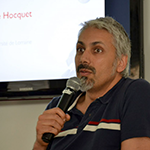
Alexandre Hocquet
Alexandre is Professor of History of Science at the Université de Lorraine, France. He also has a background in chemistry. Together with his colleague Frédéric Wieber at the Laboratory Archives Henri-Pointcaré he investigates software as an agent in the change of research cultures in computational chemistry.
Stefanie Haupt: Your research is collaborative. Together with your colleague Frédéric, you are exploring software as “the elephant in the room”. How do you exchange thoughts, observations and notes to conduct your research together?
Alexandre Hocquet: We are both computer nerds, so we like to explore what is possible. I don’t use usual word processors like Microsoft Word because I think, they keep you locked within the logic of a typewriter. And if you consider the history of such programs, this is what they emulate: a typewriter (“What you see is what you get”).” Instead, my colleague Frédéric and I are using text editors compatible with the markdown language. It means that features like bold text, hyperlinks… are part of the text itself. Text and code are displayed on the same level. This way, you are in control of what you want to do with the text and how it should look like, without being dependent on any piece of software.
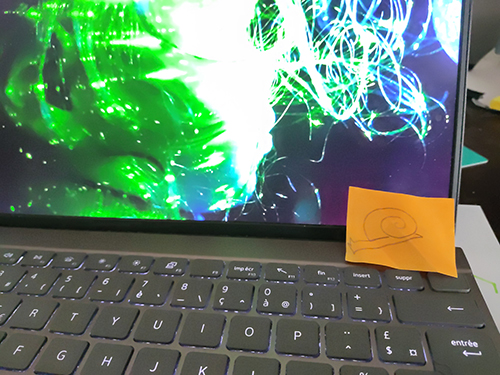
Stefanie: This sounds like you are working digitally right from the start.
Alexandre: Yes. I think, for 20 years, I haven’t used a pen in research contexts. I only pick up pen and paper when my 3-year old daughter urges me to draw together with her.
Stefanie: So, how do you take notes then, exactly?
Alexandre: The text editor I use is called ZIM (https://zim-wiki.org/). But there are other options: Frédéric, for example, uses a different editor. Everything I note down – thoughts, drafts, copy pasted texts from different online sources, hyperlinks – goes in there as raw text files. Since I can attribute different features to the text via markdown language, we have more compatibility within a shared text, even though we use different pieces of software. Also, as we are using the git versioning system, when Frédéric and I exchange and share files, the history of edits allows us to retrace changes and previous versions. You can compare the way it looks like to the open code in Wikipedia, where you can also see all (past) edits in an entry.
And how do you take notes yourself?

Stefanie: I definitely prefer taking notes with pen and paper. Or rather: pencil and paper. For my dissertation project, I am keeping a journal in which I note down stuff, for example ideas, next steps or excerpts from literature and archival records. And since in most archives you are not allowed to bring a pen into the reading room, I am used to writing with pencils. I already have an impressive collection of pencils from the German Federal Archive! It is easier for me to erase and redo notes when taken with a pencil; also, some inks come with ingredients that can do damage to paper, and, since I have a history of working with museum collections, I am careful around archival material. Furthermore, I feel more free to use the space of a piece of paper than being forced by the word processor to start in the upper left and fill a page down to the lower right. Just as we are speaking, I am adding comments to my own notes on this interview and drawing links between different keywords. So I am wondering: How do you actually overcome this linear order within your digital notes?
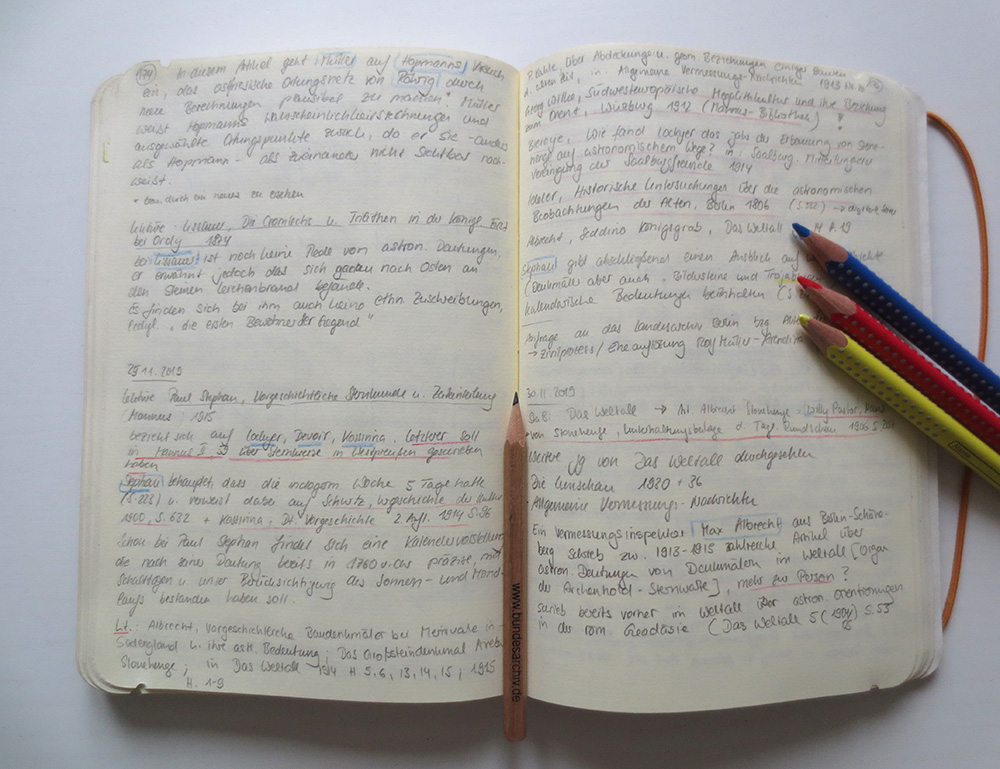
Alexandre: First, I would say the ordering structure of the zim software opens up more possibilities and gives the opportunity to curate a network of text files to one’s own needs. I structure the files via the hierarchy of the folders. Analogue to your meta comments next to the notes that you take on the paper, I would most probably create a new file and link it to the other files, or even to web pages. This way, I build up my own referencing system and have a kind of network of notes and drafts that I can also browse through with the search function. It is like a private archive of my research. How do you search through your notes yourself?
Stefanie: I must admit, the search function is most convenient! In my dissertation journal, I also tried to make my notes more accessible by creating and index on the last pages of the notebook. In alphabetical order, I listed all names of historical protagonists of my topic mentioned in the notebook with respective page numbers so that I can find the notes on them more easily. Yes I know, crazy work! But it forced me to review my notes again which helped me to engage more deeply into them. What were your habits of note taking when you were still working as a chemist? Did anything change after you switched disciplines?
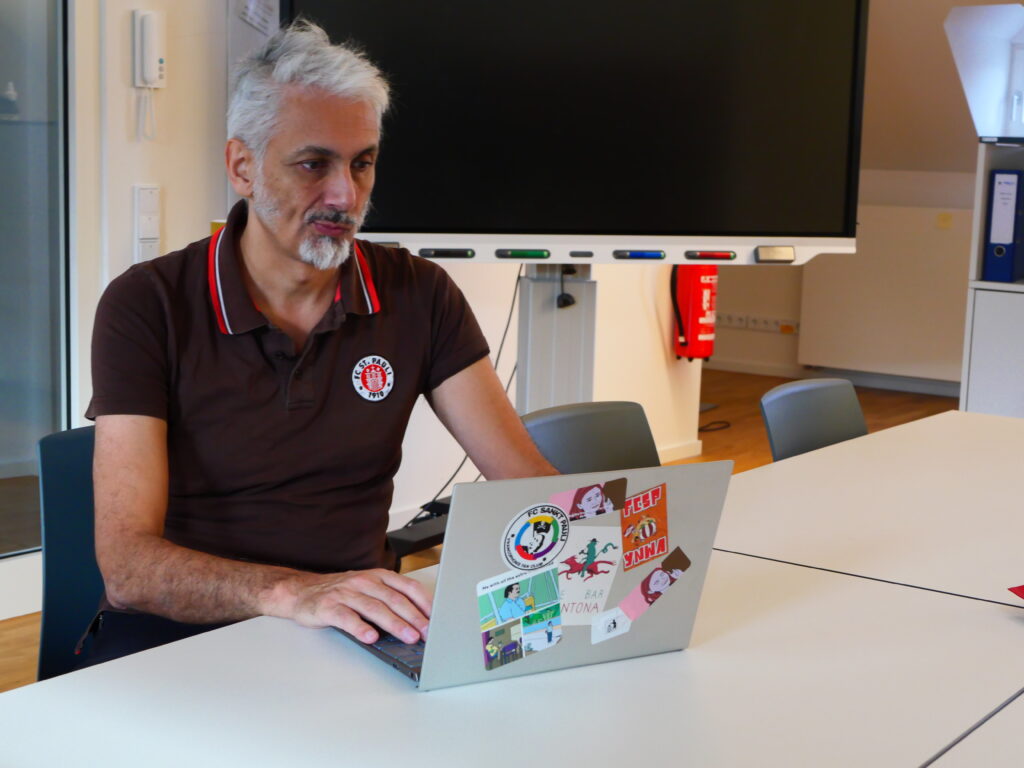
Alexandre: I honestly cannot remember how I took notes when working as a scientist. Back then it was still difficult to include chemical formulas into digital texts. It was easier to draw them manually and then scan and paste them into the text. But I guess, there are more elegant ways around that nowadays. My interest as a historian has switched: as a scientist I was depended on the software – now I am looking behind its interface and I am interested in its licensing systems, its design and the relationship between the software and the user. Maybe this is reflected by my choices in tools for note taking, too.
Stefanie: Thank you, Alexandre!
Alexandre: And thanks to you!

